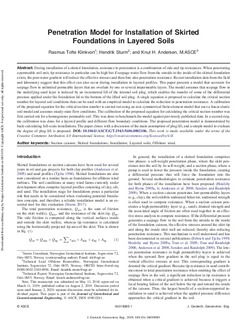| dc.contributor.author | Klinkvort, Rasmus Tofte | |
| dc.contributor.author | Sturm, Hendrik | |
| dc.contributor.author | Andersen, Knut H | |
| dc.date.accessioned | 2019-08-21T09:27:33Z | |
| dc.date.available | 2019-08-21T09:27:33Z | |
| dc.date.created | 2019-08-13T11:16:29Z | |
| dc.date.issued | 2019 | |
| dc.identifier.citation | Journal of Geotechnical and Geoenvironmental Engineering. 2019, 145 (10), . | |
| dc.identifier.issn | 1090-0241 | |
| dc.identifier.uri | http://hdl.handle.net/11250/2609461 | |
| dc.description.abstract | During installation of a skirted foundation, resistance to penetration is a combination of side and tip resistances. When penetrating a permeable soil unit, tip resistance in particular can be high but if seepage water flow from the outside to the inside of the skirted foundation exists, the pore water gradient will reduce the effective stresses and therefore also penetration resistance. Recent installation data from the field and laboratory suggest that this effect can also occur during installation in layered profiles. This paper presents a model that accounts for seepage flow in unlimited permeable layers that are overlain by one or several impermeable layers. The model assumes that seepage flow in the underlying sand layer is induced by an incremental lift of the internal soil plug, which enables the transfer of some of the differential pressure applied under the foundation lid to the bottom of the lifted soil plug. A single equation is proposed to calculate the critical suction number for layered soil conditions that can be used with an empirical model to calculate the reduction in penetration resistance. A calibration of the proposed equation for the critical suction number is carried out using an axis symmetrical finite-element model that uses a linear elastic soil model and assumes steady-state flow conditions. The calibration of the proposed equation for calculating the critical suction number was first carried out for a homogenous permeable soil. This was done to benchmark the model against previously published data. In a second step, the calibration was done for a layered profile and different flow boundary conditions. The proposed penetration model is demonstrated by back-calculating full-scale installations. The paper closes with a discussion of the main assumption of plug lift, and a simple model to evaluate the degree of plug lift is proposed. | |
| dc.description.abstract | Penetration Model for Installation of Skirted Foundations in Layered Soils | |
| dc.language.iso | eng | |
| dc.title | Penetration Model for Installation of Skirted Foundations in Layered Soils | |
| dc.type | Peer reviewed | |
| dc.type | Journal article | |
| dc.description.version | publishedVersion | |
| dc.source.pagenumber | 11 | |
| dc.source.volume | 145 | |
| dc.source.journal | Journal of Geotechnical and Geoenvironmental Engineering | |
| dc.source.issue | 10 | |
| dc.identifier.doi | 10.1061/(ASCE)GT.1943-5606.0002106 | |
| dc.identifier.cristin | 1715529 | |
| cristin.unitcode | 7452,4,3,0 | |
| cristin.unitcode | 7452,4,2,0 | |
| cristin.unitname | Offshore geoteknikk | |
| cristin.unitname | Computational Geomechanics (CGM) | |
| cristin.ispublished | true | |
| cristin.fulltext | original | |
| cristin.qualitycode | 2 | |
